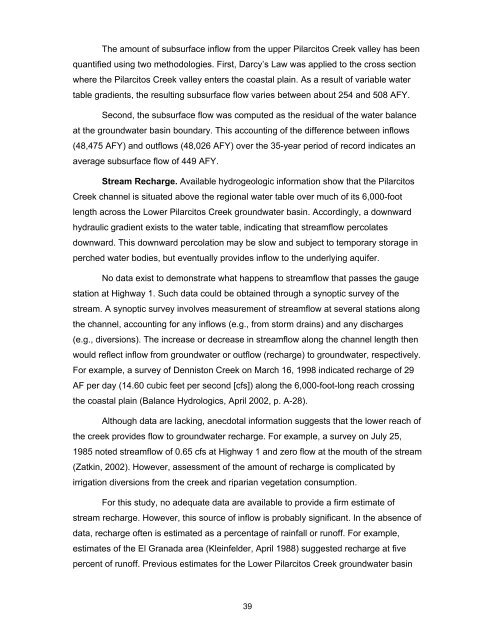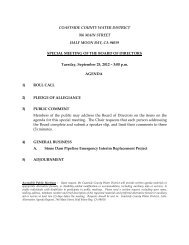Lower Pilarcitos Creek Groundwater Basin Study - Coastside ...
Lower Pilarcitos Creek Groundwater Basin Study - Coastside ...
Lower Pilarcitos Creek Groundwater Basin Study - Coastside ...
Create successful ePaper yourself
Turn your PDF publications into a flip-book with our unique Google optimized e-Paper software.
The amount of subsurface inflow from the upper <strong>Pilarcitos</strong> <strong>Creek</strong> valley has been<br />
quantified using two methodologies. First, Darcy’s Law was applied to the cross section<br />
where the <strong>Pilarcitos</strong> <strong>Creek</strong> valley enters the coastal plain. As a result of variable water<br />
table gradients, the resulting subsurface flow varies between about 254 and 508 AFY.<br />
Second, the subsurface flow was computed as the residual of the water balance<br />
at the groundwater basin boundary. This accounting of the difference between inflows<br />
(48,475 AFY) and outflows (48,026 AFY) over the 35-year period of record indicates an<br />
average subsurface flow of 449 AFY.<br />
Stream Recharge. Available hydrogeologic information show that the <strong>Pilarcitos</strong><br />
<strong>Creek</strong> channel is situated above the regional water table over much of its 6,000-foot<br />
length across the <strong>Lower</strong> <strong>Pilarcitos</strong> <strong>Creek</strong> groundwater basin. Accordingly, a downward<br />
hydraulic gradient exists to the water table, indicating that streamflow percolates<br />
downward. This downward percolation may be slow and subject to temporary storage in<br />
perched water bodies, but eventually provides inflow to the underlying aquifer.<br />
No data exist to demonstrate what happens to streamflow that passes the gauge<br />
station at Highway 1. Such data could be obtained through a synoptic survey of the<br />
stream. A synoptic survey involves measurement of streamflow at several stations along<br />
the channel, accounting for any inflows (e.g., from storm drains) and any discharges<br />
(e.g., diversions). The increase or decrease in streamflow along the channel length then<br />
would reflect inflow from groundwater or outflow (recharge) to groundwater, respectively.<br />
For example, a survey of Denniston <strong>Creek</strong> on March 16, 1998 indicated recharge of 29<br />
AF per day (14.60 cubic feet per second [cfs]) along the 6,000-foot-long reach crossing<br />
the coastal plain (Balance Hydrologics, April 2002, p. A-28).<br />
Although data are lacking, anecdotal information suggests that the lower reach of<br />
the creek provides flow to groundwater recharge. For example, a survey on July 25,<br />
1985 noted streamflow of 0.65 cfs at Highway 1 and zero flow at the mouth of the stream<br />
(Zatkin, 2002). However, assessment of the amount of recharge is complicated by<br />
irrigation diversions from the creek and riparian vegetation consumption.<br />
For this study, no adequate data are available to provide a firm estimate of<br />
stream recharge. However, this source of inflow is probably significant. In the absence of<br />
data, recharge often is estimated as a percentage of rainfall or runoff. For example,<br />
estimates of the El Granada area (Kleinfelder, April 1988) suggested recharge at five<br />
percent of runoff. Previous estimates for the <strong>Lower</strong> <strong>Pilarcitos</strong> <strong>Creek</strong> groundwater basin<br />
39



